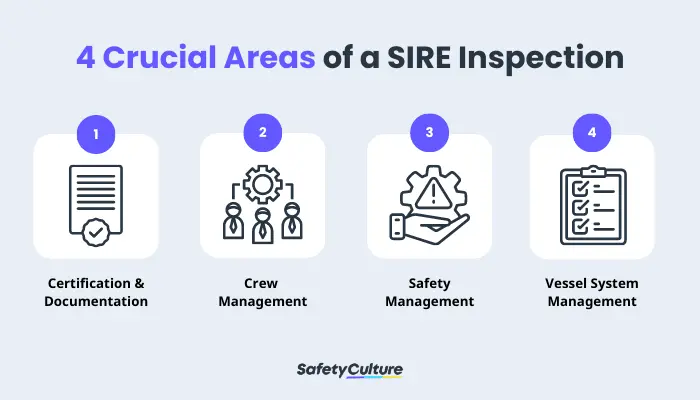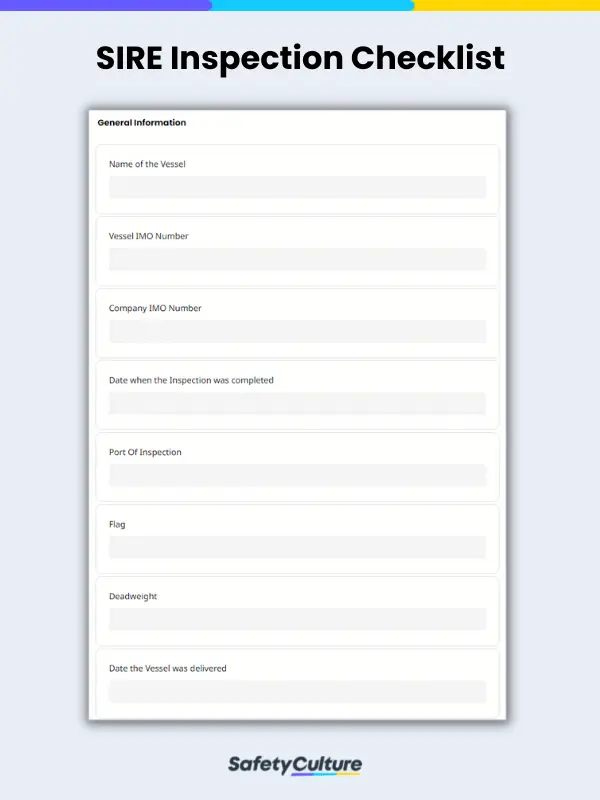What is a SIRE Inspection?
A SIRE (Ship Inspection Report Programme) inspection is a standard assessment done by tanker owners and operators to identify operational deficiencies in their shipping vessels. It is used to determine whether a vessel or barge follows SIRE programme standards set by the OICMF. Performing regular SIRE Inspections can help your business promote ship safety and ensure consistent quality of service in the business.
What is a SIRE Inspection Checklist?
A sire inspection checklist is a document that lists the items that should be inspected when performing a SIRE inspection. The items on a sire inspection checklist can unique to the vessel and the list of items to check can vary depending on the organization that is performing the inspection but typically includes the crucial areas such as the vessel’s hull, onboard equipment, and crew.
What a SIRE Inspection Checklist Include
A SIRE Inspection Checklist is used by oil and chemical companies to evaluate the safety, environmental, and operational standards of a vessel before chartering it. Its contents may vary depending on the specific needs of a business or organization, but here are items that are typically included in the checklist:
- General Information – the name of the vessel, vessel IMO number, date of inspection etc.
- Documentation – certifications, logbooks, crew certificates
- Safety management – proper procedures, audit reports, drills, and trainings
- Publications – SOLAS, LSA Code, International Code for Fire Safety Systems etc.
- Crew management – manning levels, personnel hours of rest, communication ability
- Navigation – navigational equipment, policies, procedures, and documentation
- Security – compliance with ISPS code, security measures
- Safety procedures – enclosed space, pump room entry, non-cargo spaces, hot work, mooring, ship-to ship-operations
- Equipment – gas analyzing, life-saving, fire fighting, mooring, anchoring, communication,
- Pollution prevention – marine pollution emergency plans, cargo operations, deck area
Importance of Using a SIRE Checklist
When you are a SIRE inspector, you must apply the highest possible performance standards in relation to the vessel you are inspecting. Using a SIRE inspection checklist can help cover everything that is relevant in making sure that the vessel is safe for seafarers and passengers, and is in compliance with all applicable regulations. A comprehensive SIRE checklist is a great help to ensure the safety of everyone involved.
4 Crucial Areas of a SIRE Inspection
A SIRE Inspection is performed using the SIRE Vessel Inspection Questionnaires (VIQs), a set of detailed questionnaires which addresses issues associated with safety and pollution prevention. The questionnaire contains 12 chapters highlighting the following crucial areas:

- Certification & Documentation
Check and evaluate whether your business has all the required documents and certification (e.g., Certificate of ). Operating a vessel without these required certifications and documentation can cause legal ramifications that negatively impact operation and business. - Crew Management
In this section, both officers and crew members are evaluated to check if they follow the principles of safe manning and operator’s policy. Personnel are also evaluated on their communication competencies and reviewed if they have adequate training and experience. Consistent evaluation of ship personnel reduces the likelihood of worker accidents or even equipment damage. - Safety Management
“This section examines the application of safety provisions derived from SOLAS safety standards to ensure maritime safety. This entails assessing if safety systems are in place like the use of PPE’s and having procedures for investigation and reporting of accidents, incidents, non-conformities and more. The availability of lifesaving and fire-fighting equipment is also checked in this section to prepare for life-threatening situations. - Vessel System Management
This section encompasses most of the SIRE programme chapters for visual inspection. Items relating to the general appearance and condition of the vessel fall under this category (e.g., Vessel structure, engine, machinery, mooring, cargo, ballast, etc.). Performing regular checks of vessel systems lowers the chances of ship malfunction and unexpected costly repairs and allows you to immediately act on problem areas that could cause grave repercussions in the long run.
How is SIRE Inspection Conducted?
A SIRE inspection is conducted to identify any deficiencies that may affect the seaworthiness of the vessel. The inspector reviews the vessel’s construction, equipment, and safety features. It also includes the following:
- Survey of the vessel’s crew and their ability to operate the vessel safely
- Review the vessel’s documents, including the certificates of registry and classification
- Review of the vessel’s history and any previous incidents
- Check of the condition of the vessel’s equipment, including the engines, propellers, and moorings
- Check of the vessel’s safety features, including the firefighting equipment and the lifeboats
- Assessment of the condition of the vessel and its crew
- Interview of the crew to ask them about their experience and training
FAQs about SIRE Inspection Checklist
SIRE inspectors are qualified professionals who are responsible for conducting SIRE inspections to assess a vessel’s condition and ensure that it meets safety and operational standards. The highest performance standard that SIRE inspectors must practice depends on the vessel that they are inspecting, this means that they must be thoroughly familiar with the vessel and its operations in order to identify any potential issues.
SIRE 2.0 is the latest version of SIRE. It is a digitized inspection program developed by the Oil Companies International Marine Forum (OCIMF). It aims to adapt to the changing risks the industry presents, as well as elevate how inspections are performed to consistently prioritize safety.
All the reports in a database at a given time are valid, according to the OCIMF. It is, however, up to the purchasers to determine whether a specific report still meets their standards or if it needs to be removed or updated.



